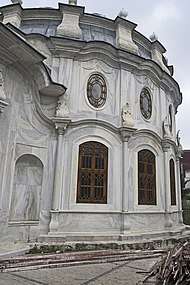Mihrimah Sultan (daughter of Mahmud II)
Mihrimah Sultan (Ottoman Turkish: مهرماہ سلطان; 29 June 1812 – 31 August 1838) was an Ottoman princess, the daughter of Sultan Mahmud II, and his fourth wife Hoşyar Kadın. She was the half-sister of Sultans Abdulmejid I and Abdulaziz.
| Mihrimah Sultan | |||||
|---|---|---|---|---|---|
 The burial place of Mihrimah Sultan is located inside the mausoleum of her grandmother Nakşidil Sultan Mausoleum, Fatih Mosque at Fatih in Istanbul. | |||||
| Born | 29 June 1812 Topkapı Palace, Constantinople, Ottoman Empire (present day Istanbul, Turkey) | ||||
| Died | 31 August 1838 (aged 26) Istanbul, Ottoman Empire | ||||
| Burial | Nakşidil Sultan Mausoleum, Fatih, Istanbul | ||||
| Spouse | Mehmed Said Pasha | ||||
| Issue | Sultanzade Abdullah Bey | ||||
| |||||
| Dynasty | Ottoman | ||||
| Father | Mahmud II | ||||
| Mother | Hoşyar Kadın | ||||
| Religion | Sunni Islam | ||||
Early life
Mihrimah Sultan was born on 29 June 1812 in the Topkapı Palace. Her father was Sultan Mahmud II, and her mother was Hoşyar Kadın,[1][2] the adoptive daughter of Sultan Mustafa III's daughter, Beyhan Sultan. She and a younger sister Şah Sultan, two years younger then her. [3]
Before the birth of Mihrimah, Mahmud had two children the following year, Şehzade Bayezid and Şah Sultan. The sultan commemorated the births of his three children together. [1]
Marriage
When time came to get her a husband, her mother resolved that she should make her choice. Her mother showed her the portraits of several young men, and she fixed upon Said Mehmed Pasha.[4] Upon the order of Mahmud, she was betrothed to the Admiral of the Fleet Mehmed Said Pasha in 1835. A dowry was prepared within a year. [1]
The marriage took place on 15 August 1835 in the Beşiktaş Waterfront Palace, when Mihrimah was twenty four years old. After the marriage was completed, 15,000 kuruş were conceded to Mihrimah Sultan. Grand Vizier Mahmud Rauf Pasha and Şeyhülislam Asim Efendi were conceded 1000 kuruş. The pashas were conceded 500 Kuruş. Damat Gürcü Halil Rifat Pasha, the husband of her half-sister Saliha also conceded some cents. The dowry of Mihrimah Sultan was prepared in Serasker. [5]
The wedding reception took place on 28 April 1836. Wedding shows of Mihrimah Sultan were held in the vicinity of Dolmabahçe like that of Saliha Sultan. These entertainments lasted for days. Finally, an enormous bride regiment was organized and Mihrimah Sultan was sent to her palace. [5] The marriage was consummated on 9 May 1836 in the Bebek Palace.[6] At the wedding of Mihrimah Sultan, where tremendous lighting shows were held and the people watched with great enthusiasm and admiration. [7]
Shortly after his marriage to Mihrimah, Said Pasha had incurred her father's displeasure and been exiled to the provinces, much to his wife's and mother-in-law's distress. At this time her mother had sufficiently sure of her influence to petition Mahmud directly, and did so in a letter. She followed this up with two letters of thanks, one when Mahmud granted her request, and ordered Said Pasha brought back to Istanbul, the other when he actually arrived.[8]
The couple had one son, Sultanzade Abdullah Bey, born on 3 July 1838. [9]
Death
Mihrimah Sultan died on 31 August 1838 of most likely tuberculosis which was raging in Istanbul in the nineteenth century [5], she was buried in the mausoleum of her grandmother in Fatih, Istanbul.[5][10]
It was said that Mihrimah loved her father very much that she once wished that she wouldn’t be alive to see the death of her father. Her wish was fulfilled and she died before Mahmud’s death. Mahmud was really saddened of her death he died the next year in 1839. [11] After her death her father contrived a fountain named Sultan Mahmud Fountain beside Nişancılar Mosque in Eyüp in the memory of his daughter. [11][12]
Issue
Together with Mehmed Said Pasha Mihrimah had one son:
- Sultanzade Abdullah Bey (3 July 1838 – 3 July 1838) [9]
See also
Ancestry
| Ancestors of Mihrimah Sultan (daughter of Mahmud II) | |||||||||||||||||||||||||||||||||||||||||||||||||||||||||||||||||||||||||||||||||||||||||||||||||||||||||||||||||||||||||||||||||||||||||||||||||||||||||||||||||||||||||||||||||||||||||||||||||||||||||||||||||||||||||||||||||||||||||||||||||||||||||||||||||||||||||||||||||||||||||||||||||||||||||||||||||||||||||||||||||||||||||||||||||||||||||||||||||||||||||||||||||||||||||||||||||||||||||||||||||||||||||||||||||||||||||||||||||||||||||||||||||||||||||||||||||||
|---|---|---|---|---|---|---|---|---|---|---|---|---|---|---|---|---|---|---|---|---|---|---|---|---|---|---|---|---|---|---|---|---|---|---|---|---|---|---|---|---|---|---|---|---|---|---|---|---|---|---|---|---|---|---|---|---|---|---|---|---|---|---|---|---|---|---|---|---|---|---|---|---|---|---|---|---|---|---|---|---|---|---|---|---|---|---|---|---|---|---|---|---|---|---|---|---|---|---|---|---|---|---|---|---|---|---|---|---|---|---|---|---|---|---|---|---|---|---|---|---|---|---|---|---|---|---|---|---|---|---|---|---|---|---|---|---|---|---|---|---|---|---|---|---|---|---|---|---|---|---|---|---|---|---|---|---|---|---|---|---|---|---|---|---|---|---|---|---|---|---|---|---|---|---|---|---|---|---|---|---|---|---|---|---|---|---|---|---|---|---|---|---|---|---|---|---|---|---|---|---|---|---|---|---|---|---|---|---|---|---|---|---|---|---|---|---|---|---|---|---|---|---|---|---|---|---|---|---|---|---|---|---|---|---|---|---|---|---|---|---|---|---|---|---|---|---|---|---|---|---|---|---|---|---|---|---|---|---|---|---|---|---|---|---|---|---|---|---|---|---|---|---|---|---|---|---|---|---|---|---|---|---|---|---|---|---|---|---|---|---|---|---|---|---|---|---|---|---|---|---|---|---|---|---|---|---|---|---|---|---|---|---|---|---|---|---|---|---|---|---|---|---|---|---|---|---|---|---|---|---|---|---|---|---|---|---|---|---|---|---|---|---|---|---|---|---|---|---|---|---|---|---|---|---|---|---|---|---|---|---|---|---|---|---|---|---|---|---|---|---|---|---|---|---|---|---|---|---|---|---|---|---|---|---|---|---|---|---|---|---|---|---|---|---|---|---|---|---|---|---|---|---|---|---|---|---|---|---|---|---|---|---|---|---|---|---|---|---|---|---|---|---|---|---|---|---|---|---|---|---|---|---|---|---|---|---|---|---|---|---|---|---|---|---|---|---|---|---|---|---|---|---|---|---|---|---|---|---|---|---|---|---|---|---|---|---|---|
| |||||||||||||||||||||||||||||||||||||||||||||||||||||||||||||||||||||||||||||||||||||||||||||||||||||||||||||||||||||||||||||||||||||||||||||||||||||||||||||||||||||||||||||||||||||||||||||||||||||||||||||||||||||||||||||||||||||||||||||||||||||||||||||||||||||||||||||||||||||||||||||||||||||||||||||||||||||||||||||||||||||||||||||||||||||||||||||||||||||||||||||||||||||||||||||||||||||||||||||||||||||||||||||||||||||||||||||||||||||||||||||||||||||||||||||||||||
References
- Uluçay 2011, p. 191.
- Sakaoğlu 2008, p. 554.
- Uluçay 2011, p. 181.
- Hanim 1872, p. 155.
- Uluçay 2011, p. 192.
- Sakaoğlu 2008, p. 554-5.
- Sunay 2017, p. 334.
- Fanny Davis (1986). The Ottoman Lady: A Social History from 1718 to 1918. Greenwood Publishing Group. p. 177. ISBN 978-0-313-24811-5.
- Adra, Jamil (2005). Genealogy of the Imperial Ottoman Family 2005. pp. 4.
- Sakaoğlu 2008, p. 554, 557.
- Uluçay 2011, p. 193.
- Sakaoğlu 2008, p. 557.
Sources
- Hanim, Melek (1872). Thirty years in the harem: or, The autobiography of Melek-Hanum, wife of H.H. Kibrizli-Mehemet-Pasha.
- Mustafa Çağatay Uluçay (2011). Padişahların kadınları ve kızları. Ankara, Ötüken.
- Sakaoğlu, Necdet (2008). Bu mülkün kadın sultanları: Vâlide sultanlar, hâtunlar, hasekiler, kadınefendiler, sultanefendiler. Oğlak Yayıncılık. ISBN 978-9-753-29623-6.
- Sunay, Serap (2017). Sûr-ı Hümayun" Defterine Göre 19. Yüzyıl Saray Düğünlerine Dair Bir Değerlendirme.
